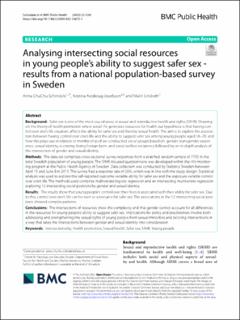| dc.contributor.author | Schindele, Anna ChuChu | |
| dc.contributor.author | Areskoug Josefsson, Kristina | |
| dc.contributor.author | Lindroth, Malin | |
| dc.date.accessioned | 2024-04-10T07:40:31Z | |
| dc.date.available | 2024-04-10T07:40:31Z | |
| dc.date.created | 2022-09-27T14:41:22Z | |
| dc.date.issued | 2022 | |
| dc.identifier.citation | BMC Public Health. 2022, 22 (1), . | en_US |
| dc.identifier.issn | 1471-2458 | |
| dc.identifier.uri | https://hdl.handle.net/11250/3125671 | |
| dc.description.abstract | Background: Safer sex is one of the most crucial areas in sexual and reproductive health and rights (SRHR). Drawing on the theory of health promotion where social life generates resources for health our hypothesis is that having con- trol over one’s life situation, affects the ability for safer sex and thereby sexual health. The aim is to explore the associa- tion between having control over one’s life and the ability to suggest safer sex among young people aged 16–29, and how this plays out in relation to membership of six constructed social groups based on: gender, transgender experi- ence, sexual identity, economy, being foreign-born, and social welfare recipiency followed by an in-depth analysis of the intersection of gender and sexual identity.
Methods: The data set comprises cross-sectional survey responses from a stratified random sample of 7755 in the total Swedish population of young people. The SRHR-focused questionnaire was developed within the HIV-monitor- ing program at the Public Health Agency of Sweden. Data collection was conducted by Statistics Sweden between April 15 and June 8 in 2015. The survey had a response rate of 26%, which was in line with the study design. Statistical analysis was used to explore the self-reported outcome variable ability for safer sex and the exposure variable control over one’s life. The methods used comprise multivariate logistic regression and an intersecting multivariate regression exploring 12 intersecting social positions by gender and sexual identity.
Results: The results show that young people’s control over their lives is associated with their ability for safer sex. Due to this, control over one’s life can be seen as a resource for safer sex. The associations in the 12 intersecting social posi- tions showed complex patterns.
Conclusions: The intersections of resources show the complexity and that gender cannot account for all differences in the resources for young people’s ability to suggest safer sex. Implications for policy and practitioners involve both addressing and strengthening the sexual rights of young people from sexual minorities and tailoring interventions in a way that takes the intersections between gender and sexual identity into consideration. | en_US |
| dc.language.iso | eng | en_US |
| dc.rights | Navngivelse 4.0 Internasjonal | * |
| dc.rights.uri | http://creativecommons.org/licenses/by/4.0/deed.no | * |
| dc.title | Analysing intersecting social resources in young people’s ability to suggest safer sex - results from a national population-based survey in Sweden | en_US |
| dc.type | Peer reviewed | en_US |
| dc.type | Journal article | en_US |
| dc.description.version | publishedVersion | en_US |
| cristin.ispublished | true | |
| cristin.fulltext | original | |
| cristin.qualitycode | 1 | |
| dc.identifier.doi | 10.1186/s12889-022-13672-1 | |
| dc.identifier.cristin | 2055977 | |
| dc.source.journal | BMC Public Health | en_US |
| dc.source.volume | 22 | en_US |
| dc.source.issue | 1 | en_US |
| dc.source.pagenumber | 0 | en_US |

